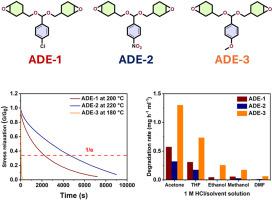Our official English website, www.x-mol.net, welcomes your
feedback! (Note: you will need to create a separate account there.)
Electronic effects of substituents on the properties of recyclable epoxy resins containing aromatic acetal groups
Polymer ( IF 4.1 ) Pub Date : 2024-06-10 , DOI: 10.1016/j.polymer.2024.127280 Innocent Toendepi , Jianwei Han , Yinqiao Liu , Liying Zhang , Yi Wei , Wanshuang Liu
Polymer ( IF 4.1 ) Pub Date : 2024-06-10 , DOI: 10.1016/j.polymer.2024.127280 Innocent Toendepi , Jianwei Han , Yinqiao Liu , Liying Zhang , Yi Wei , Wanshuang Liu

|
Both environmental and economic concerns are pioneering the development of recyclable thermosetting polymers. In this study, three liquid acetal-containing di-epoxide monomers (ADEs) with different para-substituted (-OCH, -Cl and –NO) phenyl groups were synthesized. The refractive indices and viscosities of the three di-epoxide liquids increase in the sequence of ADE-3 (-OCH), ADE-1 (-Cl) and ADE-2 (-NO). Once cured with methylhexahydrophthalic anhydride, the three cured ADEs exhibit high glass transition temperatures (181–218 °C). Due to the presence of dynamic acetal bonds, all three cured ADEs are reprocessable, repairable, weldable, and degradable. Interestingly, the electronic effect of the substituents on the phenyl group significantly impacts the structural configuration, reprocessability and degradation behaviors of the resultant cured ADEs. As the electron-withdrawing effect of the substituents on the phenyl group increases, the stress relaxation rates of the cured ADEs decrease at the same temperature. Under optimized reprocessing conditions, the reprocessed ADE-1 (-Cl) and ADE-2 (-NO) resins show the highest (117 %) and lowest (67 %) retention rates for tensile strength, respectively. The degradation rates of the three cured ADEs in the acidic solutions decrease with increasing the electron-withdrawing effect of the substituent on the phenyl group. Finally, a di-epoxide curing system based on ADE-3 was applied to prepare carbon fiber-reinforced composites, and nondestructive recovery of the carbon fibers was attained by degradation of the resin matrix.
中文翻译:

取代基对含芳香缩醛基团的可回收环氧树脂性能的电子效应
环境和经济问题正在推动可回收热固性聚合物的开发。在本研究中,合成了三种具有不同对位取代(-OCH、-Cl 和 -NO)苯基的液态含缩醛二环氧化物单体(ADE)。三种二环氧化物液体的折射率和粘度按ADE-3 (-OCH)、ADE-1 (-Cl) 和ADE-2 (-NO) 的顺序增加。一旦用甲基六氢邻苯二甲酸酐固化,三种固化的 ADE 就会表现出高玻璃化转变温度 (181–218 °C)。由于动态缩醛键的存在,所有三种固化的 ADE 都可再加工、可修复、可焊接和可降解。有趣的是,苯基上取代基的电子效应显着影响所得固化 ADE 的结构构型、可再加工性和降解行为。随着苯基上取代基吸电子效应的增加,固化的ADEs在相同温度下的应力松弛率降低。在优化的再加工条件下,再加工的 ADE-1 (-Cl) 和 ADE-2 (-NO) 树脂分别表现出最高 (117%) 和最低 (67%) 的拉伸强度保留率。三种固化的 ADE 在酸性溶液中的降解率随着苯基上取代基吸电子效应的增加而降低。最后,采用基于ADE-3的双环氧化物固化体系制备碳纤维增强复合材料,并通过树脂基体的降解实现碳纤维的无损恢复。
更新日期:2024-06-10
中文翻译:

取代基对含芳香缩醛基团的可回收环氧树脂性能的电子效应
环境和经济问题正在推动可回收热固性聚合物的开发。在本研究中,合成了三种具有不同对位取代(-OCH、-Cl 和 -NO)苯基的液态含缩醛二环氧化物单体(ADE)。三种二环氧化物液体的折射率和粘度按ADE-3 (-OCH)、ADE-1 (-Cl) 和ADE-2 (-NO) 的顺序增加。一旦用甲基六氢邻苯二甲酸酐固化,三种固化的 ADE 就会表现出高玻璃化转变温度 (181–218 °C)。由于动态缩醛键的存在,所有三种固化的 ADE 都可再加工、可修复、可焊接和可降解。有趣的是,苯基上取代基的电子效应显着影响所得固化 ADE 的结构构型、可再加工性和降解行为。随着苯基上取代基吸电子效应的增加,固化的ADEs在相同温度下的应力松弛率降低。在优化的再加工条件下,再加工的 ADE-1 (-Cl) 和 ADE-2 (-NO) 树脂分别表现出最高 (117%) 和最低 (67%) 的拉伸强度保留率。三种固化的 ADE 在酸性溶液中的降解率随着苯基上取代基吸电子效应的增加而降低。最后,采用基于ADE-3的双环氧化物固化体系制备碳纤维增强复合材料,并通过树脂基体的降解实现碳纤维的无损恢复。































 京公网安备 11010802027423号
京公网安备 11010802027423号